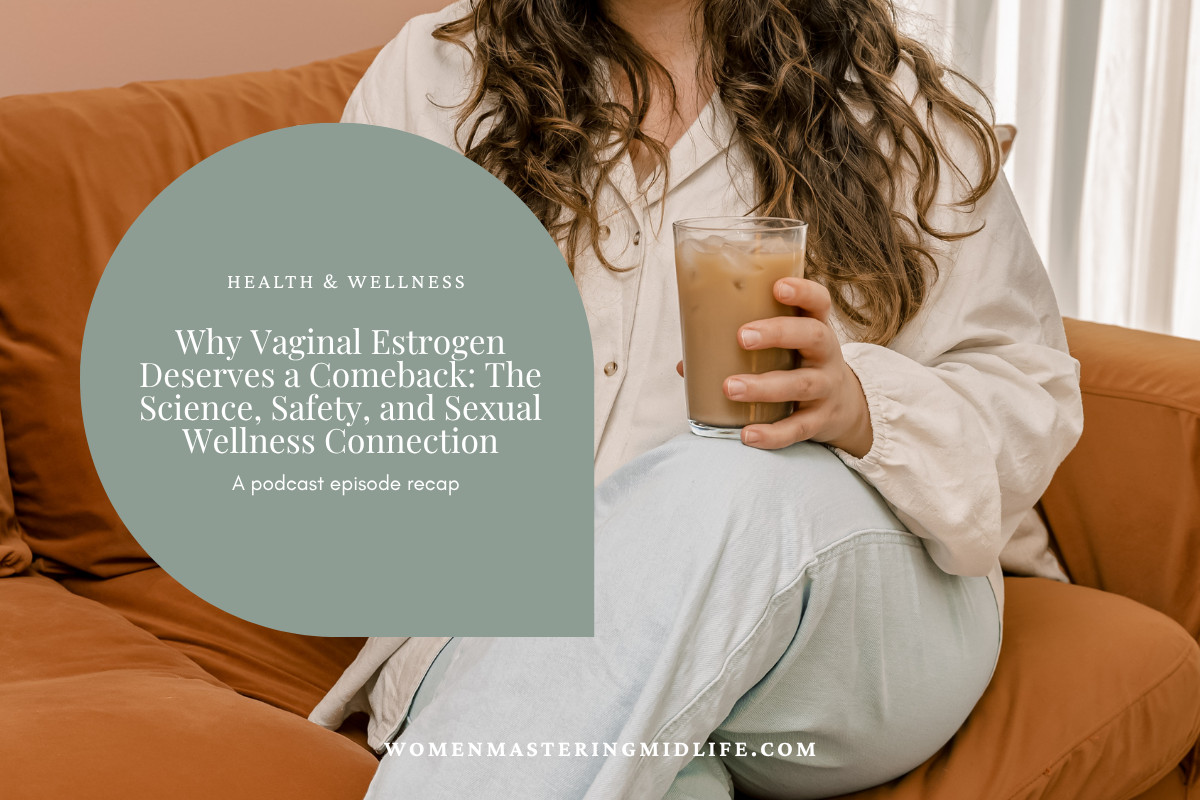Why Vaginal Estrogen Deserves a Comeback: The Science, Safety, and Sexual Wellness Connection
For too long, conversations about vaginal health have been sidelined, censored on social media, avoided in exam rooms, and overshadowed by misinformation. Yet, for millions of women in perimenopause and menopause, genitourinary syndrome of menopause (GSM) is more than a quality-of-life issue; it is a public health concern.
Up to 80% of menopausal women experience GSM, which includes symptoms such as vaginal dryness, burning, painful intercourse, and recurrent urinary tract infections. Despite that, many suffer in silence or are handed lubricants instead of real solutions.
What’s Actually Happening to Your Body
During perimenopause and menopause, estrogen levels decline, and those hormonal changes directly affect the vaginal and urinary tissues. Estrogen helps keep the vaginal walls thick, elastic, and acidic enough to support healthy bacteria. When estrogen drops, those tissues thin, lose moisture, and become more vulnerable to infection and irritation.
Nurse practitioner Vanessa Weiland, who specializes in menopause care, explains:
“As the vaginal tissue thins, the healthy bacteria disappear, the acidity drops, and infections or dryness become more common. Even bladder support structures weaken, which can lead to urgency, frequency, and leakage.”
This cluster of symptoms—dryness, pain with sex, and UTIs—is precisely what GSM describes.
Vaginal Estrogen: The Gold-Standard Therapy
There is a reason vaginal estrogen remains the most effective treatment for GSM. It replenishes estrogen locally, restoring vaginal tissue thickness, elasticity, and lubrication. It also helps prevent UTIs and improves comfort during intimacy.
Formulations include:
Creams (applied internally or externally)
Tablets or suppositories (inserted vaginally and dissolve easily)
Rings (inserted and left in place for three months)
Weiland often recommends the cream because “it’s affordable, effective, and can be used both internally and externally for maximum benefit.”
Importantly, vaginal estrogen can safely be used even in women taking systemic hormone therapy (patches, pills, or gels) since whole-body estrogen does not always reach vaginal tissues in sufficient amounts.
Let’s Talk Safety and the Black Box Warning
Perhaps the biggest barrier to treatment is fear. Decades ago, after the 2002 Women’s Health Initiative study, the FDA added a black-box warning to all estrogen products, warning of increased risks of blood clots, heart disease, dementia, and breast cancer.
That warning, however, was based on oral systemic doses, not the tiny localized doses used in vaginal estrogen(which are roughly 1/100th the strength).
“There’s no evidence that vaginal estrogen increases those risks,” says Weiland. “It’s considered safe even for women with a history of breast cancer or blood clots.”
Both the American College of Obstetricians and Gynecologists (ACOG) and the North American Menopause Society (NAMS) have published guidelines confirming its safety and efficacy. As of today, the FDA has agreed to remove the black box warning! This is huge news for Women’s Health!
Beyond Menopause: When Else It Helps
While GSM is most common post-menopause, it is not exclusive to it. Weiland notes that vaginal estrogen can also benefit women who are:
In perimenopause, experiencing fluctuating estrogen
Breastfeeding, when estrogen levels are naturally low
Using birth control pills that suppress natural hormone production
Undergoing gender-affirming testosterone therapy, which can thin vaginal tissues
The therapy helps improve comfort, blood flow, and sexual satisfaction across all these life stages.
Vaginal DHEA: Another Promising Option
A newer treatment, vaginal DHEA (Intrarosa), is a daily suppository that converts into both estrogen and androgens inside the vaginal tissues. For women whose primary issues are arousal or muted orgasm, Weiland finds DHEA particularly useful.
“Those tissues are highly sensitive to androgens,” she explains, “so DHEA can enhance blood flow and sensation, not just lubrication.”
Why Lubricants and Hyaluronic Acid Aren’t Enough
Over-the-counter lubricants and hyaluronic acid moisturizers can provide temporary relief, but they do not treat the underlying hormonal deficiency. “They’re supportive tools,” Weiland says, “but vaginal estrogen directly addresses the tissue changes that cause discomfort in the first place.”
Pelvic Floor Therapy: The Unsung Partner
Vaginal estrogen is powerful, but pelvic floor physical therapy takes results even further. It strengthens or relaxes the muscles around the bladder and vagina, depending on what is needed. Contrary to popular belief, not all women need to tighten their pelvic floors—many actually need to release tension.
Yoga and hydration also help improve circulation and tissue health.
Together, pelvic PT and vaginal estrogen are like peanut butter and jelly—different roles, but better together.
What to Know Before You Talk to Your Provider
Because sexual health is still a taboo topic, it may not come up during a typical visit. Weiland encourages women to:
Book a separate appointment to focus solely on sexual and urinary health
Use validated tools like the Menopause Rating Scale (available free on Science Direct) to guide the discussion
Bring recent guidelines (ACOG, NAMS, or AUA) if your provider is hesitant about prescribing
If you are experiencing recurrent UTIs, painful intercourse, or vaginal dryness, you do not have to live with it, and antibiotics or lubricants are not your only options.
The Bottom Line
Vaginal estrogen is not just about restoring comfort; it is about restoring confidence, intimacy, and quality of life. It is time to rewrite the narrative. This is not a “niche” therapy—it is essential healthcare for half the population.
And as Weiland reminds us, “Tell your grandmother, your sister, your best friend—everyone can and should know about this. Vaginal estrogen is safe, effective, and life-changing.”


